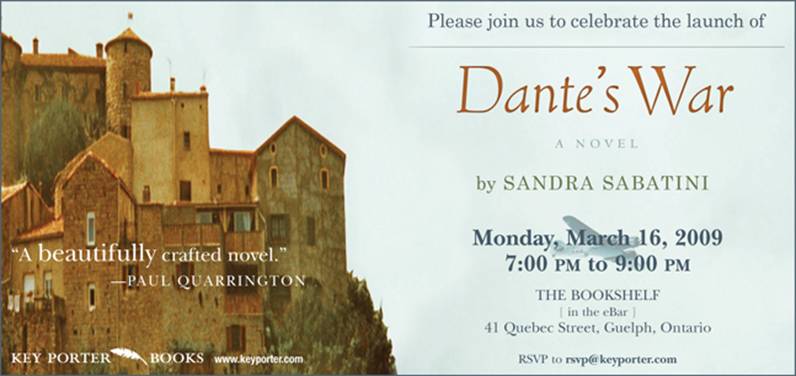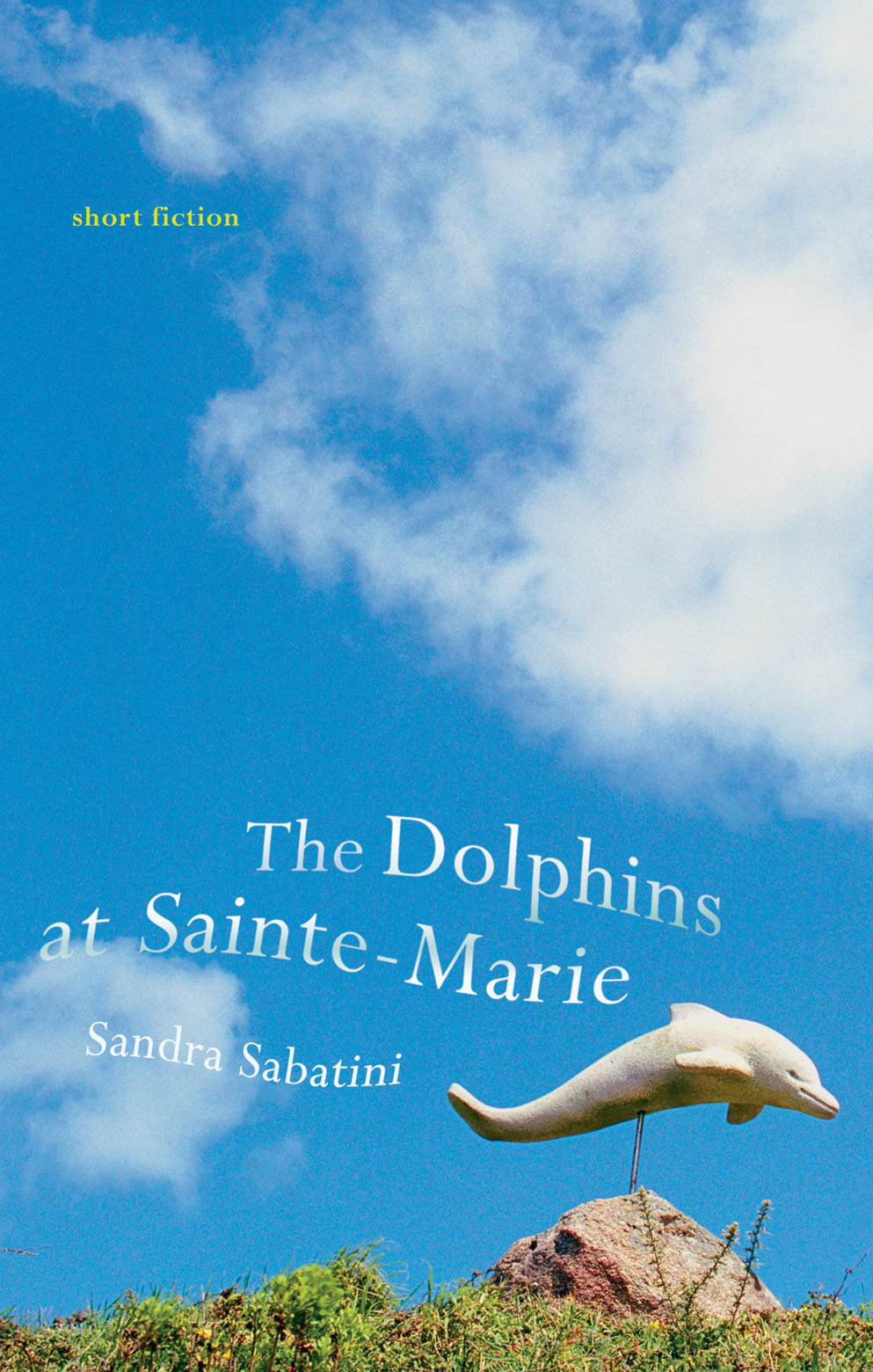PRAISE FOR DANTE'S WAR
“Dante's War is written in the fluid prose that derives from careful crafting. It lifts off the page like a song, both mythic and lyrical. A prize-worthy novel, it is a new take on an old war, both disturbing and profound, ethereal and earthbound. Like Angelina, who "was something the foaming sea would crest against," Sabatini shows remarkable strength and resilience in telling this captivating tale.” — THE GLOBE AND MAIL
“Dante's War is beautifully crafted and written. What I admire about it most is that Sandra Sabatini understands how things work: fearsome machines and weapons of war, national governments and small towns, and—most impressively—the human heart.” — PAUL QUARRINGTON, award-winning author of The Ravine and King Leary
“Sabatini’s accomplishment is to show us with sympathy the lives of “enemy” soldiers and civilians, whose native suspicion and stubborn allegiance to the soil first endanger them and ultimately save them, from the ravages of other peoples’ wars.” — NATIONAL POST
“During a bitter war, a sweet love story... Sabatini is a magician who makes innocence and experience coexist.” — ANNABEL LYON, author of Oxygen and The Best Thing for You
A new take on an old war
REVIEWED BY BARBARA MCLEAN
PUBLISHED APRIL 4, 2009UPDATED MARCH 27, 2017
Dante's War, by Sandra Sabatini, Key Porter, 360 pages, $27.95
When we first meet Dante De Angelis, an Italian aircraft mechanic, he is retreating from his war. Mired in the sands of North Africa, he comes upon a downed British flier, dying in the dust. Instead of killing him, he shares his precious water and prays for him.
The pilot, before he dies, thanks Dante, his enemy. Such irony runs through this compelling first novel set in the Second World War and told from an Italian perspective.
From the desert prologue, the novel rewinds to the infancies of the romantic couple at the heart of Sandra Sabatini's novel, growing up separately in the shadow of fascism. Dante is born in a fury, so large and obstinate that his mother has no further children. His clenched fists foretell his future as a scrapper, a fellow who finds himself in trouble at home, at school and throughout his military career.
Angelina, conversely, is born in a flurry, her mother giggling, having time only to spread a tablecloth beneath her for the easy delivery. Their childhoods mirror their births: Dante's difficult and painful, fraught with injuries from an abusive father and insults from contagious diseases, Angelina's calm and self-sufficient in the fecund farmland of her rural village.
Sabatini is a writer living in Guelph, Ont., and the author of the short-story collection The One With the News . Her Italian landscapes are visually cinematic. Dante's Spoleto, with its ancient Ponte delle Torri, its trees, acacias and sun-drenched gardens, is a place of childhood adventure and of terror. The bridge is a character in itself, a place of discovery and intrigue, a hermit in a cave at one end, the town at the other and a large, round window midway carved in the stone.
Angelina's village is a cornucopia of wild cherries, almonds, figs olives, hazelnuts, persimmon, plums, yews, cypress and pines. Cornflowers, wild rose and hyacinths bloom in the grass. Raised in domesticity, she helps her mother at the well, washing linens in the pooling water and pressing lemons to "knuckle the dirt out of the clothes." Laundry is a language for women who read each other's stories by the stains on their sheets.
Sabatini infuses her narrative with delicious Italian delicacies, from food and flowers to the language itself. Never blatant, her translations of Italian dialogue are so subtle as to make the reader feel some innate knowledge of the tongue, to pause and sound out the music of the words and absorb their meaning effortlessly.
The villagers grow their own rich and sensual food, pulsing with colour and taste. Angelina rubs fresh rosemary deftly between her palms into her pot of potatoes, and the air is replete with the aroma of warm bread, of artichokes, pasta, beans, tomatoes, pecorino, minestra , bistecca . But bucolic bliss is overshadowed by politics as Mussolini dreams of empire and forms the Axis with Hitler.
Destined to meet, Dante and Angelina are soon young adults visiting Rome. Dante is on leave, having completed his military training, and Angelina is helping in her aunt's shop. Their connection is tenuous and abbreviated, but charged with anticipation. Angelina becomes Dante's Beatrice, and her image and letters carry him through his wartime inferno.
Dante is posted to the Balkans, the tiny Mediterranean island of Pantelleria and then North Africa, and his story intersects with those of historical heroes from the Italian air force and the German Luftwaffe to Rommel himself. As a mechanic, Dante has an intimate relationship with planes. The technical details are meticulous and convincing.
War's horror swells for Dante on the front lines and for Angelina at home. Soldiers are caught "in a strong wind … to toss them like the chaff from the field, tossed high in the air to separate it from the wheat, to watch it blow across the mountains until it disappeared." From bravado to ambivalence to antagonism, Italians come to see their boys as fighting for useless lands. They die in the fatal snows of Russia and the wilderness of the desert, where "God himself has turned his hind parts."
Dante and his childhood pal Sabino remain together in the struggle, each marking for the other their "place in the world." From purloining a plane, flying it from Pantelleria to Sicily and stealing cherries, to peeling potatoes in punishment, to cleaning their uniforms with petrol when they have lice but no water, they rely on their friendship.
Despite rumours of foreign atrocities at home, where Nazi soldiers have become "governors and enforcers," Dante remains linked to his Axis brothers in arms, another inevitable irony of war. They have "terrible things to remember" that would be "more terrible … to forget." At home with the partisans, the priest asks, "Did you find, when you killed the German soldiers, that their blood was a different colour?"
Dante's War is written in the fluid prose that derives from careful crafting. It lifts off the page like a song, both mythic and lyrical. A prize-worthy novel, it is a new take on an old war, both disturbing and profound, ethereal and earthbound. Like Angelina, who "was something the foaming sea would crest against," Sabatini shows remarkable strength and resilience in telling this captivating tale.
Barbara McLean is the author of From the Ashes in Dropped Threads 3: Beyond the Small Circle.
Dante's War
Highbrow fiction whopping good yarn
Reviewed by: Douglas J. Johnston
Posted: 03/15/2009 1:00 AM | Comments: 0
0 0 REDDIT0 TUMBLR0 0 PRINT E–MAIL Dante's War
By Sandra Sabatini
Key Porter, 360 pages, $28
Dante's War is what's known as literary fiction -- highbrow stuff, as opposed to "popular" fiction. But it's also a whopping good yarn.
Guelph resident Sandra Sabatini's debut novel -- her earlier works of fiction were short-story collections, The One with the News (2000) and The Dolphins at Sainte-Marie (2006) -- fairly revels in telling a story, and telling it well.
And though it adroitly mixes history and romance, none dare call it historical romance.
What it is, is a realistic portrayal of the intersection of private lives and public events.
The Dante of the book's title is Dante De Angelis. Son of an abusive minor Fascist functionary in Mussolini's pre-Second World War government in the northern Italian town of Spoleto, Dante's a good kid (aptly named, his surname translates as "Of the Angels").
Not daunted by his upbringing, he turns into a fine and resilient young man, though his childhood and adolescence render him constitutionally rebellious against arbitrary authority of any stripe.
Still, beguiled by Mussolini's imperialist visions and, just as critically, bored with small-town life, Dante and his childhood friend Sabino enlist in a military academy that grooms them to be, and graduates them as, soldiers of Il Duce's ill-fated would-be second Roman empire.
On leave in Rome on the eve of his deployment, the young soldier meets and falls in love with Angelina. She, a fellow child of rural Italy, temporarily in the big city to help out in a relative's store, reciprocates.
On a subsequent leave, he journeys to her village and meets her family.
On the basis of these two brief encounters -- and letters to and from the various fronts Dante is posted to -- a firm but chaste courtship is cemented.
That skeletal outline does little justice to Sabatini's ability to tell a charming and even lyrical love story, but without the affectation that sometimes infects lyrical writing.
The balance of the novel unwinds as a tale of the small, medium and large savageries that govern both military and civilian life during a war.
Alternate chapters detail Dante's variously funny, sad and tragic experiences of combat and Angelina's trials in Nazi-occupied Italy.
(Italy's government and king Victor Emmanuel III forced Mussolini to resign, and signed an armistice with the Allies in 1943. Hitler subsequently rescued Mussolini, and reinstated him as a puppet dictator in northern Italy.)
All the ingredients are here -- good plot, great narrative pace, solid three-dimensional characters and mesmerizing evocations of times and places.
Ultimately Dante's War is a nifty example of the versatility of writing that aspires to be art.
Douglas J. Johnston is a Winnipeg lawyer and writer.
Republished from the Winnipeg Free Press print edition March 15, 2009 B8
Short and Bittersweet
Sandra Sabatini: short-story champion
By Andrea Curtis
July 6, 2006
Author Sandra Sabatini. Courtesy Penguin Group Canada.
For something so apparently innocuous, the short story has a surprising ability to carve out battle lines among book lovers. There are those who sing the praises of the concentrated nature of the form, the way a single image can be seared into your mind, the way each word, each idea, counts. The rival chorus grumbles about this brevity, complaining that as soon as they’re drawn into the author’s world, they are spit out again, left with nothing meatyto chew on.
On the business end of things, there is also a great divide. Writers tend to like writing short stories. Maybe it’s because they get to see the fruits of their labour in journals and magazines, a more immediate gratification than the long lead times in book publishing; or because they have accepted the long-held (and occasionally accurate) belief that gathering 10 or 15 stories and calling it a collection is an ideal way to launch one’s credibility and career. But most literary agents and publishers will tell you — albeit with regret — that short fiction doesn’t sell; unless, that is, your name happens to be Raymond Carver or, say, Alice Munro, in which case it not only sells, but wins buckets of awards and praise of thebest-living-writer-in-the-universe variety.
Publishing a book of short stories can be a fraught and potentially demoralizing exercise — one that comes with the added irritation of being asked when you will write a “real” (i.e., full-length) book. But Sandra Sabatini, a Guelph, Ont.-based writer whose taut and richly imagined short fiction collection, The Dolphins at Sainte-Marie, is out this week, doesn’t really see it that way.
“I love short stories — reading them, writing them,” she says on the phone during a recent visit to Kingston, Ont. “And with five children, my writing gets done in the evenings, between the children’s homework and activities. I remember reading an interview with Alice Munro, who said the reason she wrote short stories in the beginning was because she had small children and short bursts of time to work. I think that’s been true for me, too.”
Dolphins is actually Sabatini’s third book — a rather amazing feat considering her children range in age from 11 to 21 and are all still at home. Not to mention her other work at the University of Guelph as a research administrator and occasional English instructor. Her first collection of short stories, The One with the News, was shortlisted for the Upper Canada Writers’ Craft Award and praised for its evocative rendering of the effects of Alzheimer’s on family, caregivers and the sufferers themselves. Her second book, an academic work called Making Babies: Infants in Canadian Fiction, was based on her PhD dissertation.
Courtesy Penguin Group Canada.
The Dolphins at Sainte-Marie touches on the subjects of her previous two works (aging and children). But more than anything, this collection is about women and girls teetering on the razor’s edge — peril on one side, promise on the other. In “Water Hazards,” a girl named Connie (who turns up in several stories) spends a languid summer at the cottage hanging out with her older brother, eating Pop Rocks, swimming and fishing. But the fast-running river that makes Connie “smell like a fish” has leeches that linger along the sheltered shoreline. And there are more threatening hazards to contend with when a paunchy and, yes, lecherous man takes an interest in her. With the action always threatening to topple over into deceit, loss of innocence, even death, Sabatini’s stories are filled with a powerful tension that builds over the course of individual pieces and — despite the fact that most of the stories are not connected — over the book as a whole.
“I’m really interested in that place of tension,” she agrees. “I started thinking about these stories a few years ago when I was at one of those goofy home parties — for skin care or something. I don’t even remember what. But I was in a room full of women all roughly the same age, and talk turned to growing up in different parts of Ontario. Almost everyone in the room had a story about being approached by a creepy man, lured by someone, molestation and worse. It was an amazing, shocking sort of experience to hear these stories. And none of us was particularly outraged. I found myself wondering, why was this OK? What made it begin? Where in boyhood did boys begin to think that was a good idea? I began some of the stories with that question. But as a mother of boys — great boys — I also know that that’s not the whole story, and I wanted to write about that, too.”
Not surprisingly, the characters in Sabatini’s stories are also on the cusp of becoming in its most generous sense. In “Typical Guy Stuff,” Angela experiences that simultaneously powerful and utterly destabilizing moment when she understands herself as the object of male sexual attention. In “Holes,” Connie waits for her beloved aunts to pierce her ears and longs for access to their grown-up world, their easy camaraderie and, especially, their secrets. In “Maternal Instinct,” dealing with a fierce mother raccoon and her kits living in the chimney exposes a family’s fault lines.
The recurring Connie character is the strongest embodiment of this leitmotif, though she ranges in age through the collection — from a child to being a mother herself. “I think Connie is those women I talked to at the skin-care party,” explains Sabatini. “Any one of the stories I heard that night could have happened to her. She’s bumping into life, and so much of it is confusing and so much of it is downright evil, and yet there’s this other experience that’s so wonderful. She sees with her aunts the heritage of stories, the close world of women. I guess she’s a canvas for me.”
Sabatini’s preoccupation with the bittersweet is also played out in the summer — often cottage — setting of many of her pieces. It’s the perfect backdrop: there’s the heat and languor, the promise of empty days spilling out in front of you and, on the flip side, the menace of the outdoors, of children with newfound freedom, of bug bites, nettle stings, leeches and more. Sabatini nails this feeling with rich, economical language and lovely brush-stroke character descriptions. One female character wears “firm foundation garments that sculpted the soft mass of her flesh into a shape both solid and viscous. Hug her and you slipped off.” Sabatini also has a brilliant ear for the cadence and unvarnished cruelty of children.
This crisp style and poignant subject matter may seem particularly well-suited to the short story form, but highly distilled writing and memorable characters are hardly undesirable in longer works. Indeed, fully realized, truthful and haunting long after the book is finished, Sabatini’s collection is a kind of knockout punch for champions of short fiction. After all, great writing is great writing— whatever the format. But yes, if you really must know, she isworking on a novel.
Andrea Curtis is a Toronto writer.
CBC does not endorse and is not responsible for the content of external sites - links will open in new window.
The One with the News
A Collection of Stories
by Sandra Sabatini
Porcupine's Quill, 2000
Review by Tony O'Brien M Phil.
Feb 8th 2005 (Volume 9, Issue 6)
It is not unusual to find a work of fiction that provides a more profound description of the experience of illness than that provided in scientific or medical literature. Think of Chekov's Ward Six; Maupassant's The Horla, or Hesse's Rosshalde. Kafka's Metamorphosis can be read as an allegory that powerfully conveys the experience of psychosis. Sandra Sabatini is in good company in using fiction as a medium to portray the disintegration of a life of a man with dementia. What is unusual in The One With the News is that Sabatini has used ten linked short stories to tell the story of Ambrose; each story showing either a period in the unravelling of his life, or the same period from the perspective of different players in the drama.
Ambrose is a jeweller, known for his meticulous attention to detail. When he forgets how to make the tea, and takes to using a notepad to remind himself of day to day things, his wife Peggy knows there is something wrong. With each story we share different aspects of dementia, through the eyes of Ambrose, Peggy, daughters Alice, and Connie, the paper boy, and a caregiver. Each story is complete in itself, although as you progress through the book your understanding is enriched by deeper and deeper understanding of the web of Ambrose's life. What makes the book memorable is how Sabatini, while holding Ambrose at the centre of the narrative, provides glimpses into the lives of so many others. Gord, the caregiver at the Health Centre, rides his motorcycle to 'look for something good'. Connie is Ambrose's adopted daughter, and in the title story we learn of the special relationship she shares with Ambrose. The concluding story, a collection of reflections on Ambrose's and others' dementia, Sabatini introduces Iris Murdoch and John Bayley, marveling at Bayley's endurance as Murdoch became progressively removed from him. By exploring the lives of those close to Ambrose, Sabatini shows dimensions of Alzheimer's not normally covered, even in biographical accounts of children and spouses. In a story called 'Collecting', Sabatini shows how the changes of dementia are experienced by someone on the periphery of Ambrose's life, the boy who collects his paper money. As Ambrose becomes disorganized and forgetful, the youngster becomes afraid of the old man, and finally feels rejected by him. There is no resolution to this, as there is with family members closer to Ambrose. It is the attention to these more peripheral characters that is one of the central insights of these stories. Like the web of neurons that becomes tangled and dysfunctional in dementia, the social relationships of the individual also begin to break down and disintegrate.
Sabatini is a good storyteller. While the subject matter of dementia carries an inevitable bleakness, this is not overstated, and Sabatini does not sentimentalize Ambrose or patronize readers by gratuitously plucking at their heartstrings. Sadness and tragedy are conveyed with warmth and pathos, but Sabatini is equally adept at conveying the moments of humour that are part of any fully described life. When Ambrose ad-libs to cover up his misunderstanding about the purpose of a toaster, Sabatini allows the reader to enjoy the moment. Nor is the interest of the book confined to dementia or illness; rather, the experience of illness becomes the occasion for exploration of love, identity, hope and faith.
For a health practitioner the book is of interest for its sensitive and closely observed account of dementia. But The One With the News is also a fine piece of writing. Sabatini shows an assured use of language, and deft handling of a range of characters. The book is a pleasure to read for the restrained yet powerful way Sabatini works with what is a somewhat unforgiving plot. A highly recommended read for caregivers and professionals working with people with dementia, and for those who like an accomplished literary treatment of everyday life.





